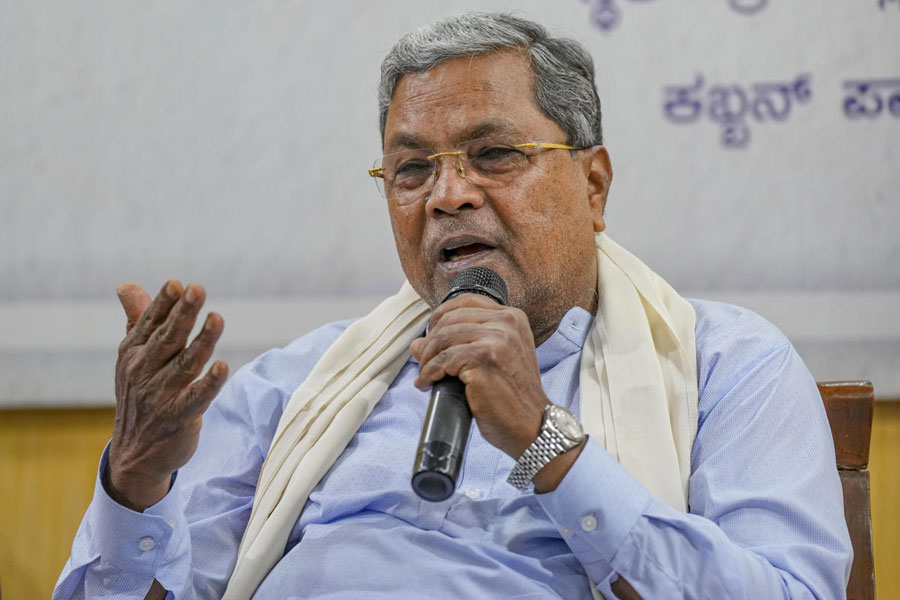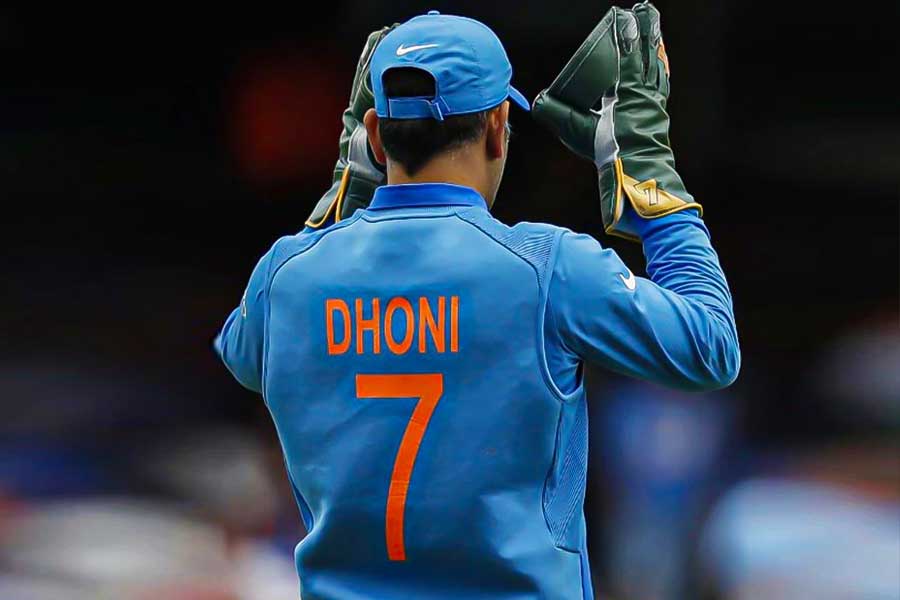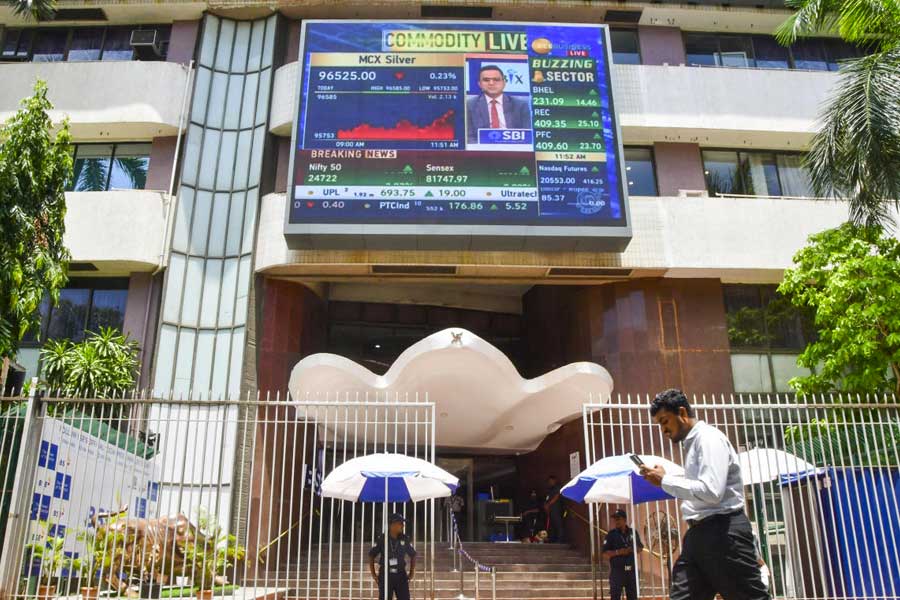 |
| The oldest of the Basu Mallik houses at 18 Radhanath Mallik Lane and (below) the relief of a mendicant at the entrance of 22 Radhanath Mallik Lane. Pictures by Sanat Kumar Sinha |
 |
Pataldanga, off College Square, is today like many other old neighbourhoods of north Calcutta with once-fine buildings crowding a narrow alley along with slums and workaday houses. These belong to middle-class Bengalis and are let out to upcountry folk.
Radhakanta Mallik Lane and Sreegopal Mallik Lane are both littered with dirt, garbage and leftover food that attract numerous cats. Barrows to carry garbage are lined outside the boundary of 22 Radhanath Mallik Lane closest to Surya Sen Street, once known as Mirjapur Street.
This house belonged to Kshetra Chandra Basu Mallik, and a little ahead is 18 Radhanath Mallik Lane, which is the oldest house of the Basu Mallik clan that once dominated the Pataldanga area. Further down is 46 Sree Gopal Mallik Lane that belonged to the man after whom the alley is named. All these three houses belong to the Basu Mallik clan whose primogenitor was Radhanath Mallik, who did not use the double-barrelled name. The double-barrelled name came to be used in early 20th century.
Many Basu clans, including that of Subbas Chandra Bose, originated in Mahinagar near Sonarpur and Rajpur in South 24-Paraganas. Gopinath Basu was a minister of Husain Shah of Gaur and had won the title of Purandar Khan. All the Basu Malliks trace their origin to Gopinath and his brother Ballav.
During Pathan rule, the Basu Malliks were persecuted by the new rulers and they were forced to seek refuge in Kantagarh close to Pandua in Hooghly.
Krishnaram Aich, who lived in Calcutta, got his daughter, Shankari, married to Ramkumar Basu Mallik of Kantagarh, who was already married. That was in 1794. Four years later, Shankari bore his son, Radhanath, who was one of the first Bengalis to learn English. He took up a job in a merchant office, and later moved on to an office that supplied goods shipped to Calcutta.
Here Radhanath got the opportunity to prove his worth, and when his boss went on leave to England, he held fort. His boss was so impressed he made Radhanath his partner.
Later he started another partnership firm with one Mr Beachamp and they bought a ship. Radhanath was going from strength to strength, and in 1831 he began to worship Durga in the thakurdalan at 18 Radhanath Mallik Lane. Later, Radhanath, along with Samuel Reed, set up the Hooghly Dock.
When Radhanath died in 1842 at age 44, he owned 40 houses and other properties in Calcutta. Radhanath had four sons — Joygopal, Dwarikanath, Dinanath and Sreegopal.
Joygopal had three sons — Prabodh Chandra (he was the father of Subodh Chandra Mallik), Manmatha Chandra and Hem Chandra. Manmatha went to France, married a Frenchwoman, and twice contested the polls in England as a Labour party candidate. Hem Chandra’s son Nirad Chandra made hefty donations to Calcutta University and also gifted the house at Raja Subodh Mallik Square to the institution.
Dwarikanath had three sons — Charu Chandra, Sarat Chandra and Kshetra Chandra, who started the puja at 22 Radhanath Mallik Lane.
Charu Chandra’s son, Narendra Chandra Basu Mallik, was the first Bengali judge of kathak at the All India Music Conference in Allahabad in 1937. His son, the 76-year-old Ashokedra, showed me around.
Little is known of Dinanath’s descendants.
Radhanath’s descendants did not share his head for business, and now it is difficult for them to maintain the property they own in Pataldanga. The oldest thakurdalan is in a bad way. Part of it had collapsed in 1983, and that section is clearly a new construction. Statuettes of Mercury are arrayed all over the courtyard. They once held gas lamps. Above the thakurdalan is a frieze depicting the ten incarnations of Vishnu, which is common enough in old houses.
The lion of the Durga image resembles a horse. When the movement against the partition of Bengal was on, Rabindranath had visited this house in 1905 and exhorted students to leave government educational institutions. Since 1916, a classical music soiree named Shankar Utsab has been organised here. It was revived in 2000.
Kshetra Basu Mallik’s thakurdalan has a cast iron frame with glass behind it. The painted Shiva-Durga image inside a shrine is visible from the lane. In the afternoon, it is crowded with mothers who come to pick up their charge. This is debuttar property, unlike the oldest thakurdalan, where family members finance the Durga puja.
The house at 46 Sree Gopal Mallik Lane with its verandah running parallel to the twists and turns of the narrow lane is the best maintained but the thakurdalan is kept under lock and key. Sreegopal had formed a trust to pay for the worship of the family deity, Sree Sree Sreedhar Nath, and Durga and Jagadhatri pujas and Rathayatra festival.
In 1956 this trust became defunct as the Basu Mallik clan lost its property on the wrong side of the border. Till then Sreegopal’s son, Satish Chandra, and thereafter the latter’s sons, Jogesh Chandra and Bhola Nath, had continued the festivities till 1947.
From then onwards, Jogesh Chandra used to organise the pujas at his own expense as he lived at 46 Sree Gopal Mallik Lane. Subsequently, his son, Shanta Chandra, who continued to live here, and the latter’s son, Subrata, have kept all the pujas going, although it is a closed-door affair.
This thakurdalan is certainly better maintained but it is almost a replica of the one at 22 Radhanath Mallik Lane. It still has an argent throne for the deity with a lion and unicorn coat of arms on the arch above. Without royal patronage few of these stately homes would have been built. We tend to forget that.










